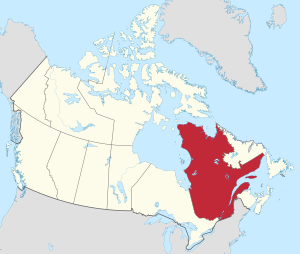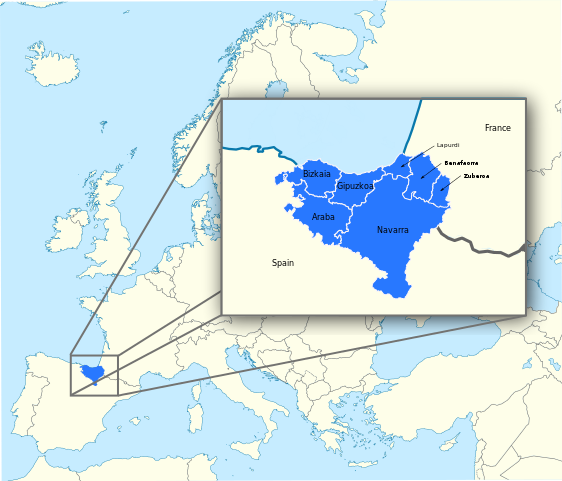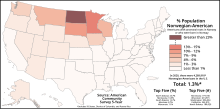Chapter 7: Race and Ethnicity
7.8 Ethnic Landscapes – Small-Scale
The character of a region that has been settled by ethnic minorities may change over time, creating the following types of ethnic landscapes:

Source: “Quebec in Canada 2” by MapGrid via Wikimedia Commons is licensed under CC BY-SA 4.0.
7.8.1 Ethnic homelands
Quebec: Large areas that have been settled by an ethnic minority for a long time. These areas may have some kind of political autonomy, landmarks, symbols, and signs in the minority’s language that marks its history and attachment to the area. An example is the French-Canadian or Québécois homeland in Quebec.
Quebec’s distinct cultural, linguistic, and historical identity within Canada isshaped by its colonial past, predominantly Francophone population, and unique socio-political landscape. It became established as New France in the 17th century, and Quebec City was founded in 1608. In 1763, France ceded New France to Britain, but the French-speaking population maintained its culture and language through the Quebec Act of 1774.
French is one of the two official languages of Canada, and it is the official language of Quebec. The preservation and promotion of the French language are central to Quebec’s identity; thus, there is a strong sense of nationalism in Quebec, with many residents identifying primarily as Québécois rather than Canadian. This has fueled political movements advocating for greater autonomy or outright independence.

Source: “Basque Country Location and Provinces in Europe Map” by Gabriel Trisca via Wikimedia Commons is licensed under CC BY-SA 3.0.
The Basque Country, known as Euskal Herria in the Basque language, is a unique region that spans parts of northern Spain and southwestern France. Just like Quebec, it is also recognized for its distinct cultural, linguistic, and historical identity, and serves as the homeland for the Basque people. The Basque language, known as Euskara, is one of the oldest languages in Europe and is unique in that it is not related to any other known language. Efforts to preserve and revitalize Euskara are central to Basque cultural identity. In addition to their language, the Basques enjoy a rich cultural heritage that includes traditional music, dance, sports (such as pelota), and cuisine. Festivals like the Aste Nagusia in Bilbao and San Fermín festival in Pamplon celebrate Basque culture.

Source: “Running of the Bulls on Estafeta Street” by Atkins525 via Wikimedia Commons is licensed under CC BY-SA 4.0.
The most iconic event of the San Fermín Festival is the “Encierro,” or Running of the Bulls. Each morning from July 7 to 14 at 8 a.m., bulls are released onto the streets of Pamplona, where they run a route to the bullring, accompanied by daring participants. The run covers 875 meters and usually lasts around three minutes.
Participants often wear white clothing and a red scarf. They run alongside or ahead of the bulls, navigating the narrow, cobbled streets. This event is both thrilling and perilous. Bullfights take place every afternoon in the Plaza de Toros (bullring) following the morning’s running of the bulls. These events are an integral part of the festival, attracting aficionados and tourists alike.
There has been a long-standing movement for greater autonomy or full independence from Spain. From the late 1950s during the years under the dictator Franco and beyond, the militant separatist group ETA (today it would be labeled a terrorist group as they seemed to ‘specialize’ in car bombs in tourist areas) pursued a violent campaign for Basque independence until it declared a ceasefire in 2011 and disbanded in 2018. The political landscape includes a range of parties, from those advocating for greater autonomy within Spain to those seeking full independence.
The Basque Country is one of the wealthiest and most industrialized regions in Spain. It has a strong economy, with key sectors including manufacturing, finance, and technology. The city of Bilbao, with its renowned Guggenheim Museum, is a cultural and economic hub.
Other examples of ethnic homelands include those in South Africa which is discussed in Chapter 7.6 Ethnic Conflicts and Kurdistan, Scotland or Tibet.
7.8.2 Ethnic substrate

Source: “Percent of Norwegian Americans by state” by Petermgrund via Wikimedia Commons is licensed under CC BY-SA 4.0.
An ethnic substrate represents an area that is no longer an ethnic homeland because its ethnic residents were assimilated into the majority culture. However, this area may still have ethnic restaurants and place names, and celebrate ethnic festivals, even though its current residents may not be familiar with the language or the history of those things. An example would be the upper Midwest, which has a large number of people of Norwegian descent, and has annual celebrations of Norway’s declaration of independence (see Figure 7.5.4).
Another ethnic substrate would be the German presence in Virginia, particularly in Fredericksburg and Richmond. The former is known for its historical ties to German settlers who arrived in the 18th and 19th centuries. The town has maintained elements of German heritage through its architecture, festivals, and community organizations.
7.8.3 Ethnic Enclaves
Ethnic enclaves are areas with a high concentration of ethnic residents, and consist of specialized amenities (e.g. places of worship, stores) catered to particular ethnic groups. Ethnic enclaves found in urban areas, close to city centers, are referred to as ethnic neighborhoods. Ethnic enclaves found in the suburbs, made up of more established and affluent residents are called ethnoburbs.

Source: “Chinatown – East Broadway” by joiseyshowaa via Wikimedia Commons is licensed under CC BY-SA 2.0.
Ethnic neighborhoods in New York City are vibrant enclaves that reflect the city’s rich cultural diversity. New York City is home to the largest overseas Chinese population of any city proper in the Western Hemisphere, with over half million. Multiple large Chinatowns in Manhattan, Brooklyn and Queens are thriving as traditionally urban ethnic enclaves, as large-scale Chinese immigration continues into New York with the largest metropolitan Chinese population outside of Asia. Chinatown (see Figure 7.8.5) offers a bustling array of markets, restaurants, and cultural institutions. Little Italy, while smaller today, still celebrates its Italian heritage with annual festivals like the Feast of San Gennaro.
Harlem, historically known as a center for African American culture, continues to thrive with a population of about 140,000 residents, enriched by jazz clubs, soul food restaurants, and historical landmarks. According to Yesenia Barrios, a writer for Latino Rebels, East Harlem communities are now facing displacement due to gentrification. Longtime residents like Minerva Cornejal, who moved from Mexico 34 years ago, have seen the neighborhood change significantly, with an influx of younger white and Asian residents and the closure of local businesses. This gentrification is transforming East Harlem’s historical identity as a working-class neighborhood, according to urban policy educator Andrew J. Padilla. In 2000, 53 percent of El Barrio’s population identified as Latino, but by 2019, this number had declined by 43 percent while the white and Asian populations roughly doubled. Median rent also increased by nearly 21 percent. Sandra Killett from Community Voices Heard notes that gentrification has been a long-standing issue, driven by those able to afford higher rents. In 2022, there were an estimated 123,097 people in East Harlem, of which 8 % identified as Asian, 30% identified as Black, 43 % identified as Hispanic, and 14 % identified as White[1].
Jackson Heights in Queens is a melting pot of South Asian and Latin American communities, with an estimated 150,000 residents enjoying a mix of cultural festivities and diverse cuisines. Brighton Beach in Brooklyn, often referred to as “Little Odessa,” has a significant Russian-speaking population of around 75,000 people. These neighborhoods not only preserve the cultural identities of their residents but also contribute to the unique, multicultural tapestry of New York City.

Source: “Islamic Center of America, Dearborn, Michigan (cropped)” by Rmhermen via Wikimedia Commons is licensed under CC BY-SA 4.0.
Dearborn, Michigan–an inner-ring suburb in the Detroit Metropolitan Area-is the epicenter of Muslim/Arab American culture. It is a microcosm of the Middle East with people from every Arab country (i.e. Lebanon, Iraq, Palestine, Syria, Yemen, Saudi Arabia, etc), featuring a multitude of Arab-owned restaurants, businesses, markets, halal butcher shops, hair salons, and mosques. Warren Avenue and Michigan Avenue are lined with signs in both Arabic and English, showcasing the city’s evolution into one of the most Arab-centric places in America. In 2023, Dearborn became the first Arab-majority city in the U.S., with a population of 110,000. It is home to the Arab American National Museum and the largest mosque in North America. The city stands out for having a Muslim Arab mayor, recognizing Eid as a paid holiday for city employees, and allowing the Islamic adhan (call to prayer) to be broadcast from mosque loudspeakers. Visitors to Dearborn can immerse themselves in Middle Eastern cuisine and witness the significant contributions of Arab Americans to the city’s identity and heritage.

Source: “India Square JC jeh” by Jim.henderson via Wikimedia Commons is licensed under CC0 1.0.
The Indian neighborhood in Jersey City, New Jersey, often referred to as “Little India,” is a bustling enclave that celebrates the rich culture and heritage of the Indian community. Located primarily along Newark Avenue, this area is renowned for its vibrant atmosphere and an array of Indian-owned businesses. The streets are lined with restaurants offering diverse regional cuisines, from spicy South Indian dosas to flavorful North Indian curries, as well as sweet shops filled with traditional desserts like gulab jamun and jalebi.Koreatown in Annandale, VA, a suburb of Washington, D.C., is a prominent Korean American enclave known for its vibrant community and cultural offerings. Dubbed “Koreatown,” it features a concentration of Korean residents, businesses like restaurants (such as Honey Pig and Bonchon) and grocery stores (like H Mart), and cultural institutions including churches and community centers. This enclave preserves Korean language, traditions, and cuisine, hosting festivals and events that celebrate Korean heritage and contributing significantly to the area’s cultural diversity. This enclave not only supports the local Korean population but also attracts visitors seeking authentic Korean experiences, thereby fostering cultural exchange and understanding.Check out this short YouTube which does not only discuss Koreatown but also the changes that Annandale experienced. Quite interesting and very short!
Another enclave within Virginia is Little Saigon that became established in the heart of Clarendon, Virginia, and was a vibrant cultural region known for its rich Vietnamese heritage and community. However, due to gentrification and rising property values in the late 1990s and early 2000s, many of these establishments were displaced. This economic pressure forced many Vietnamese business owners and residents to relocate to more affordable areas.The majority of the community and businesses that once made up Little Saigon in Clarendon moved to the nearby city of Falls Church, Virginia. This new area, often referred to as Eden Center, has since become the heart of the Vietnamese-American community in Northern Virginia. Eden Center is now a bustling commercial center with over 120 shops, restaurants, and businesses, making it a cultural and economic hub for the Vietnamese community, continuing the legacy that began in Clarendon.
The following YouTube discusses how Vietnamese came to Arlington and then were pushed out by gentrification once the metro was finished. It also showcases how the community saved itself by creating the Eden Center in Falls Church which is at this point slated for redevelopment. See this article.

